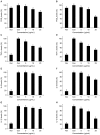Anti-Inflammatory Activity of Pinus koraiensis Cone Bark Extracts Prepared by Micro-Wave Assisted Extraction
- PMID: 27752500
- PMCID: PMC5063209
- DOI: 10.3746/pnf.2016.21.3.236
Anti-Inflammatory Activity of Pinus koraiensis Cone Bark Extracts Prepared by Micro-Wave Assisted Extraction
Abstract
In this study, we compared the anti-inflammatory activity of Pinus koraiensis cone bark extracts prepared by conventional extraction and microwave-assisted extraction (MAE). Water extracts and 50% ethanol extracts prepared using MAE were applied to RAW 264.7 cell at 5, 10, 25, and 50 μg/mL of concentrations, and tested for cytoxicity. The group treated with 50 μg/mL of 50% ethanol extracts showed toxicity. In order to investigate the inhibition of nitric oxide (NO) production in RAW 264.7 cells, extracts of water and ethanol were treated with 5, 10, and 25 μg/mL concentrations. The inhibitory activity of water and 50% ethanol extracts groups were determined as 40% and 60% at 25 μg/mL concentration, respectively. We found concentration dependent decreases on inducible NO synthase. The inhibitory effect against forming inflammatory cytokines, prostaglandin E2, tumor necrosis factor-α, interleukin (IL)-6, and IL-1β, was also superior in the 25 μg/mL treated group than the control group. According to these results, the water extracts and 50% ethanol extracts both inhibited inflammatory mediators by reducing the inflammatory response. Therefore, The MAE extracts of P. koraiensis cone bark can be developed as a functional ingredient with anti-inflammatory activity.
Keywords: Pinus koraiensis; anti-inflammation; cone bark; extracts; micro-wave.
Figures




Similar articles
-
In Vitro Bioassay-guided Isolation of Radioprotective Fractions from Extracts of Pinus koraiensis Bark.Pharmacogn Mag. 2017 Oct-Dec;13(52):712-718. doi: 10.4103/pm.pm_409_16. Epub 2017 Nov 13. Pharmacogn Mag. 2017. PMID: 29200738 Free PMC article.
-
Inhibition of Pro-inflammatory Mediators and Cytokines by Chlorella Vulgaris Extracts.Pharmacognosy Res. 2016 Apr-Jun;8(2):118-22. doi: 10.4103/0974-8490.172660. Pharmacognosy Res. 2016. PMID: 27034602 Free PMC article.
-
Effect of Microwave and Ultrasound-Assisted Extraction on the Phytochemical and In Vitro Biological Properties of Willow (Salix alba) Bark Aqueous and Ethanolic Extracts.Plants (Basel). 2023 Jul 3;12(13):2533. doi: 10.3390/plants12132533. Plants (Basel). 2023. PMID: 37447094 Free PMC article.
-
Anti-inflammatory effects of Eucommia ulmoides Oliv. male flower extract on lipopolysaccharide-induced inflammation.Chin Med J (Engl). 2019 Feb 5;132(3):319-328. doi: 10.1097/CM9.0000000000000066. Chin Med J (Engl). 2019. PMID: 30681498 Free PMC article.
-
Pinus densiflora needle supercritical fluid extract suppresses the expression of pro-inflammatory mediators iNOS, IL-6 and IL-1β, and activation of inflammatory STAT1 and STAT3 signaling proteins in bacterial lipopolysaccharide-challenged murine macrophages.Daru. 2017 Aug 4;25(1):18. doi: 10.1186/s40199-017-0184-y. Daru. 2017. PMID: 28778215 Free PMC article.
Cited by
-
Anti-nociceptive and anti-inflammatory effects of hydroalcoholic extract and essential oil of Pinus eldarica in animal models.Avicenna J Phytomed. 2021 Sep-Oct;11(5):494-504. doi: 10.22038/AJP.2021.18038. Avicenna J Phytomed. 2021. PMID: 34745921 Free PMC article.
References
-
- Hyun EA. MS Thesis. Jeju National University; Jeju, Korea: 2004. Anti-inflammatory effect of Salvia officinalis L. extract.
-
- Dagne JM, Hanson J, Supuran C, Pratico D. Coxibs and cardiovascular side-effects: from light to shadow. Curr Pharm Des. 2006;12:917–975. - PubMed
LinkOut - more resources
Full Text Sources
Other Literature Sources
